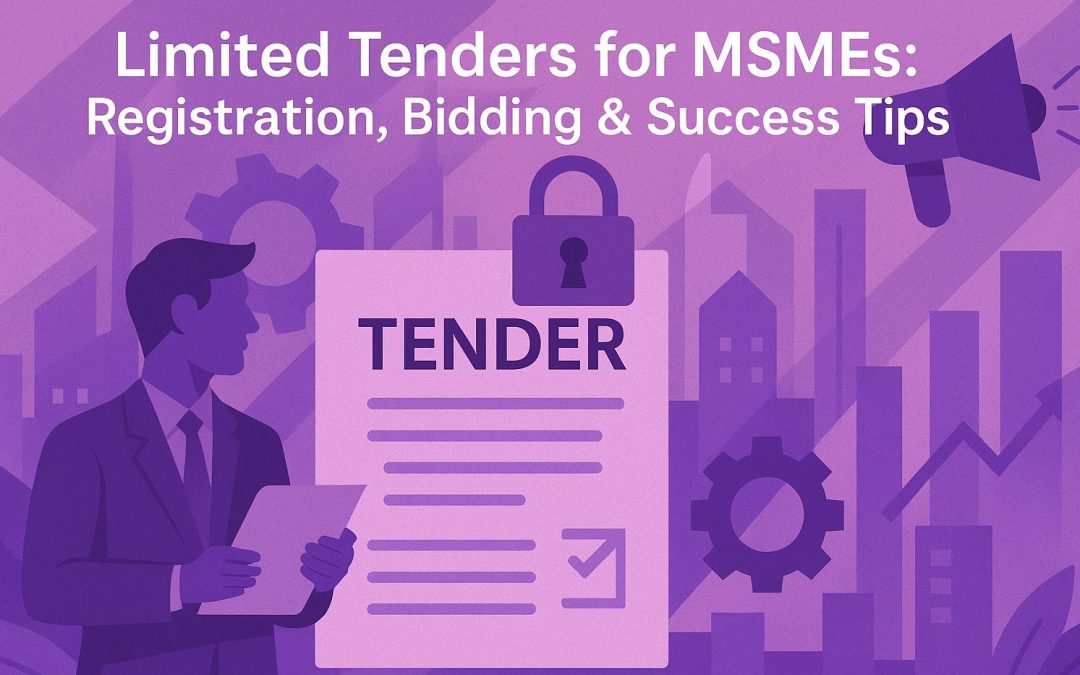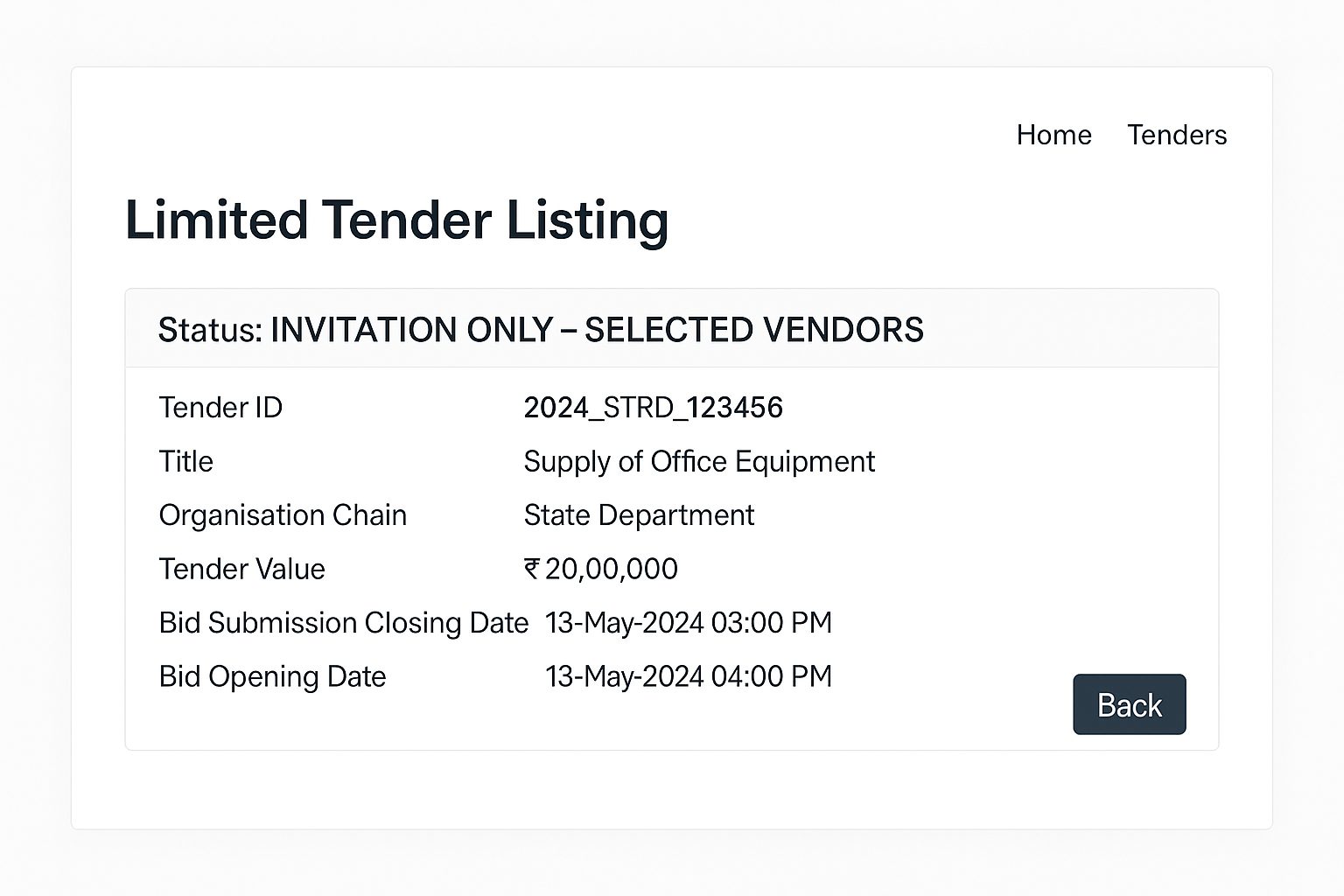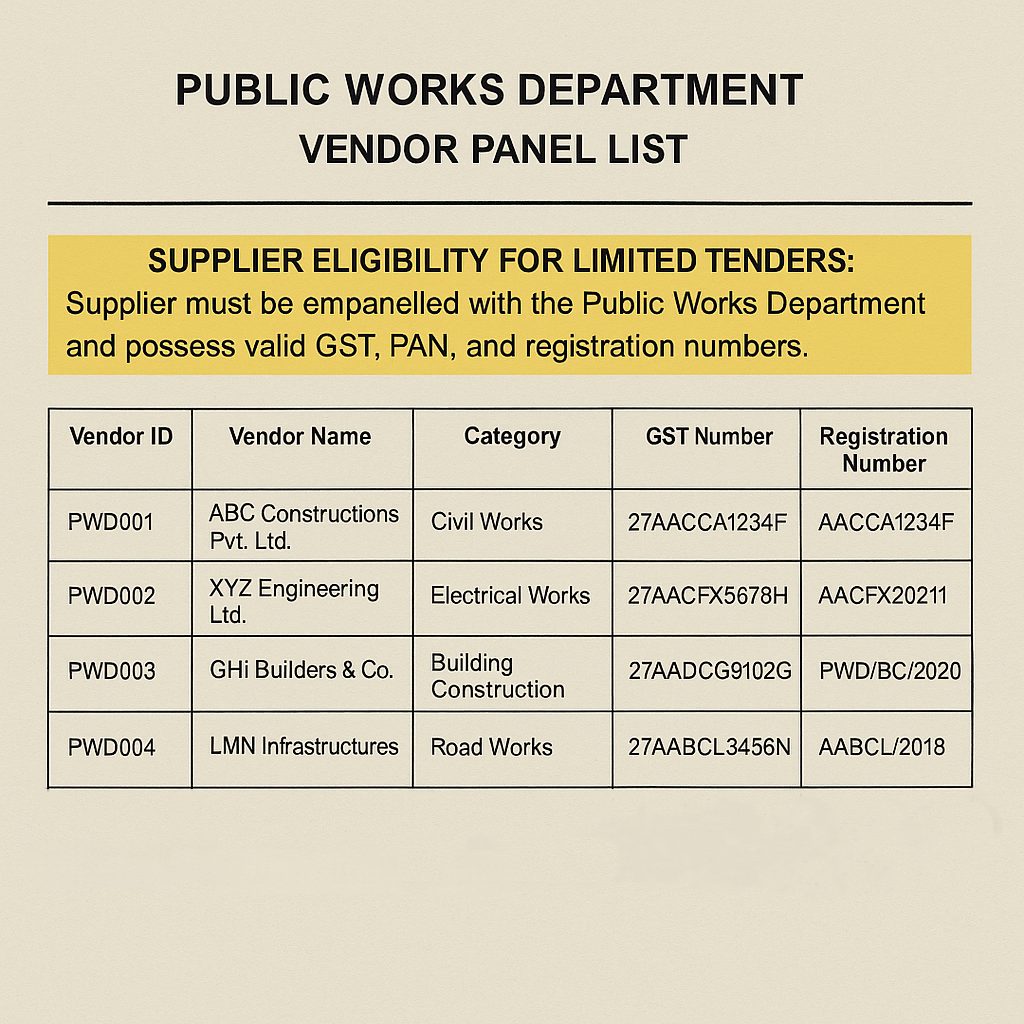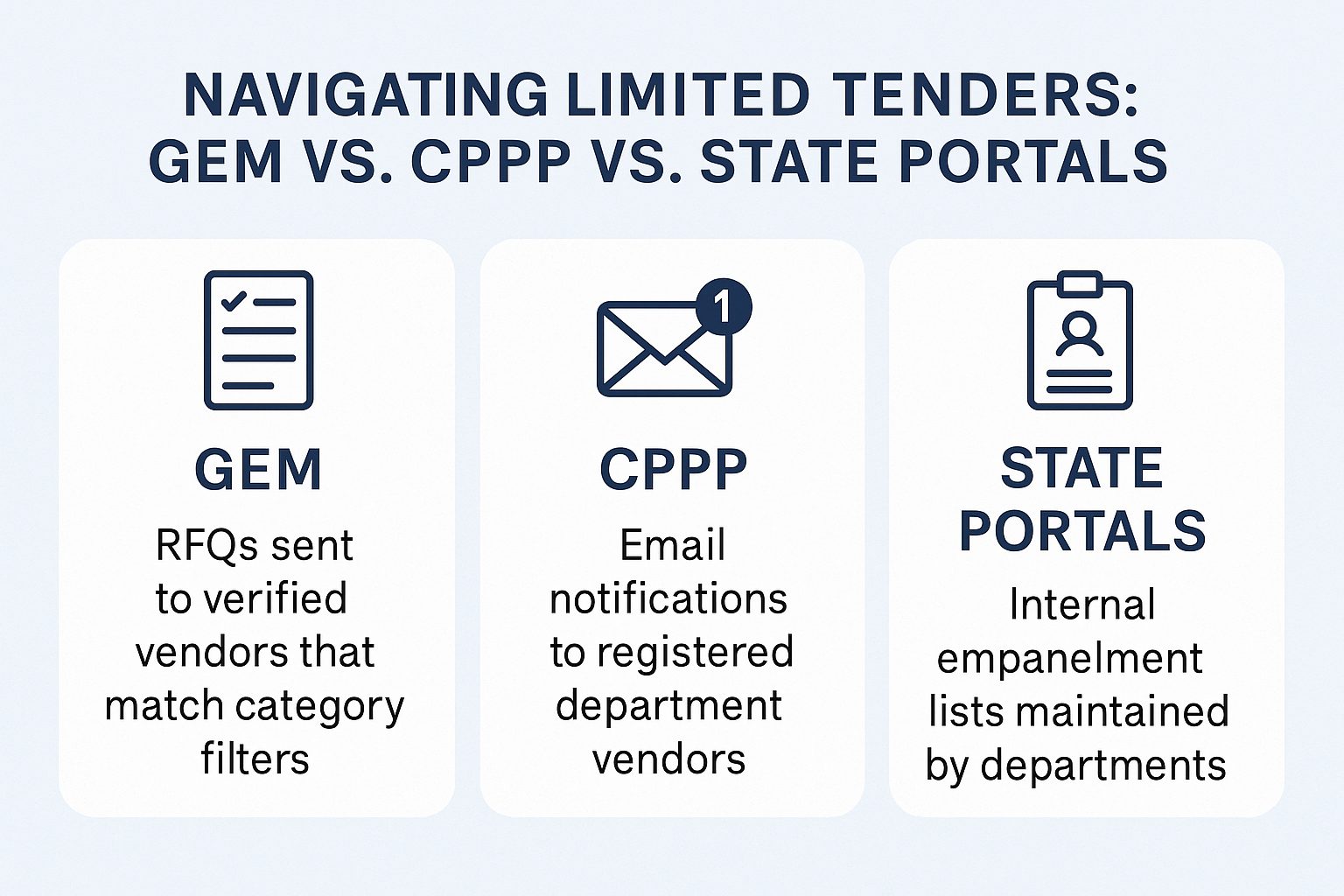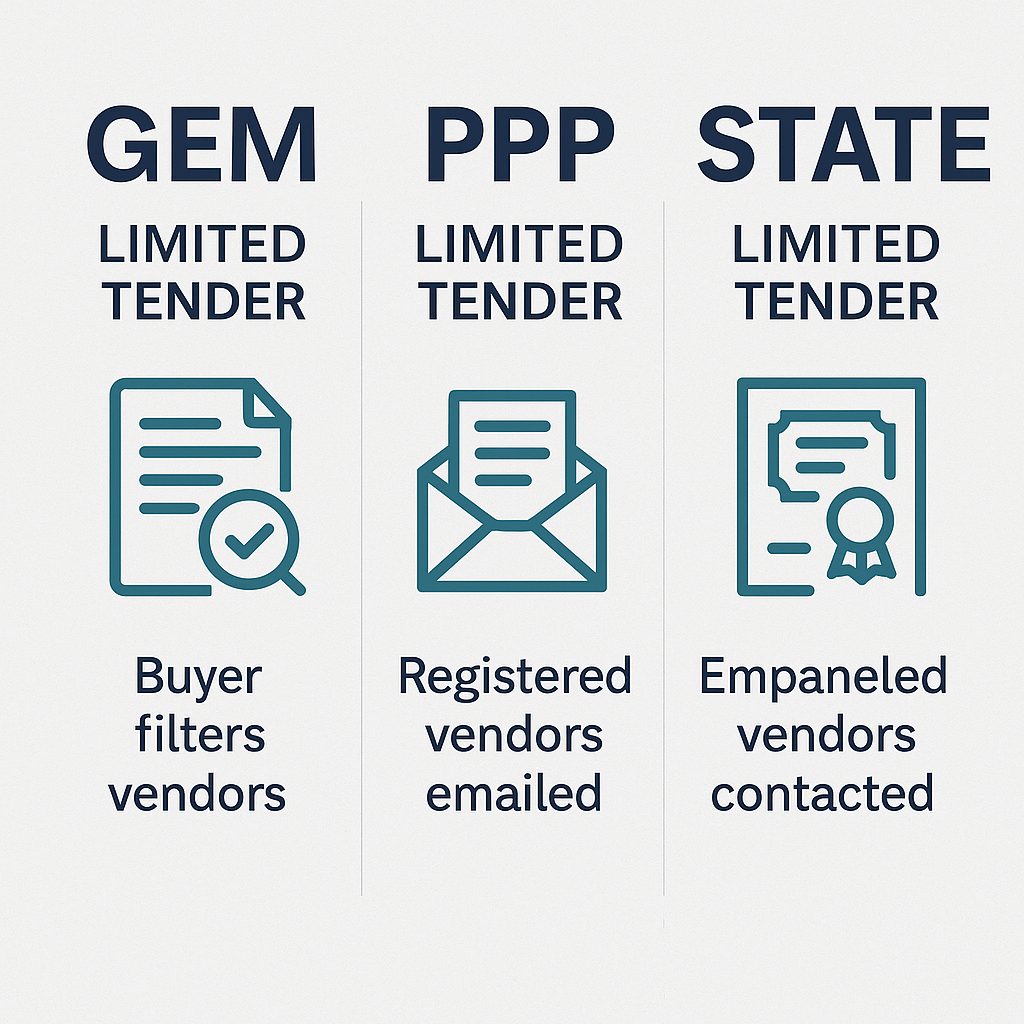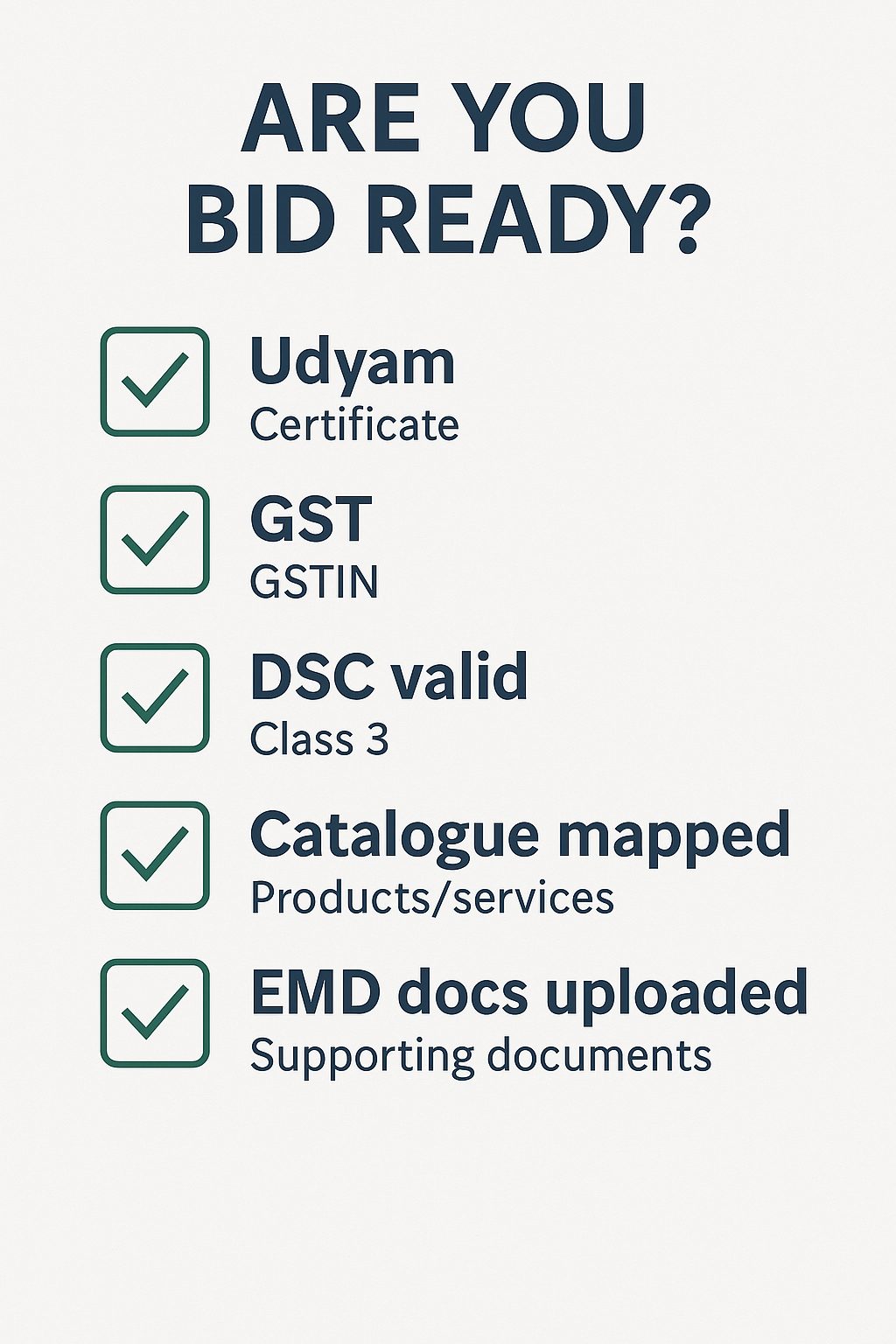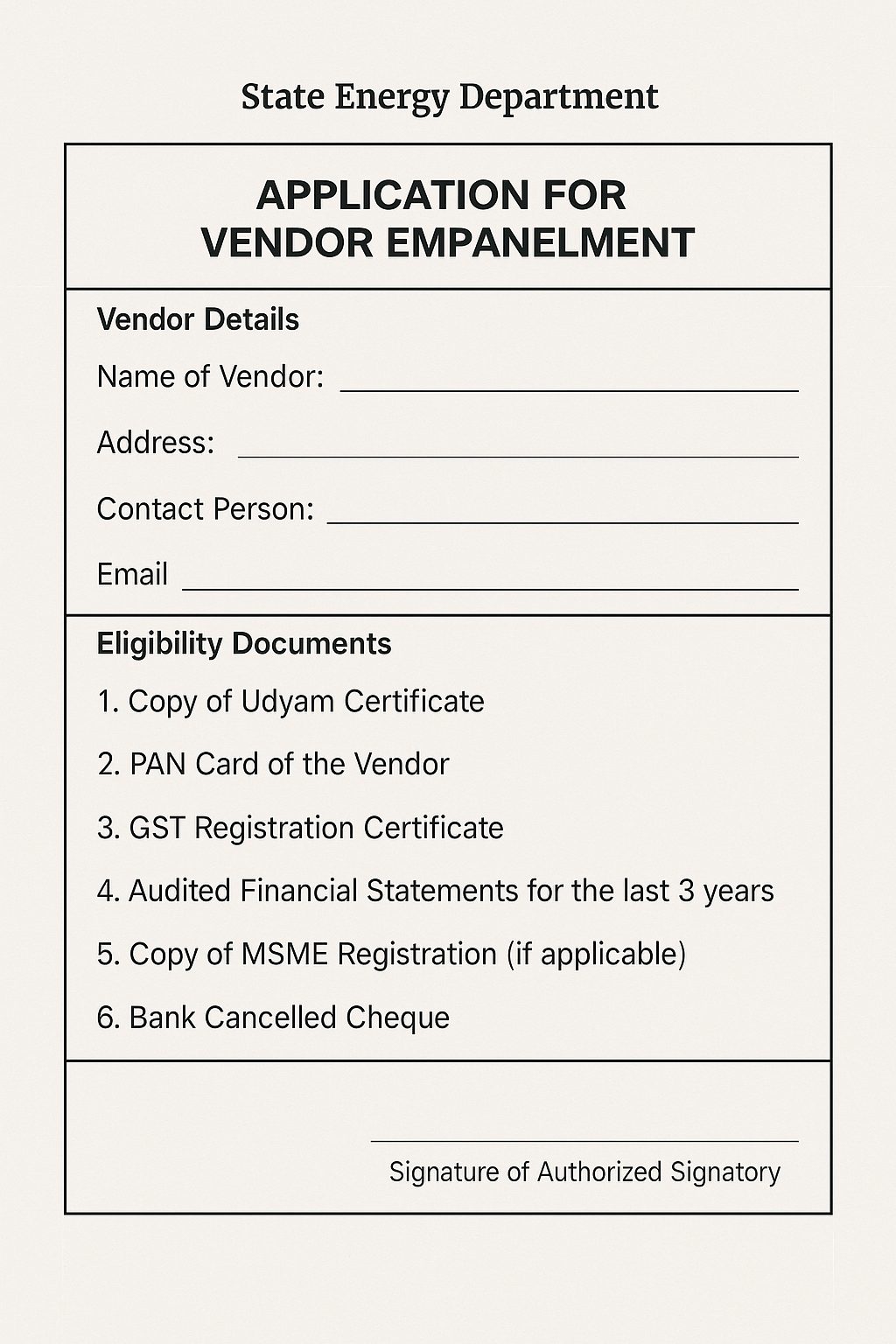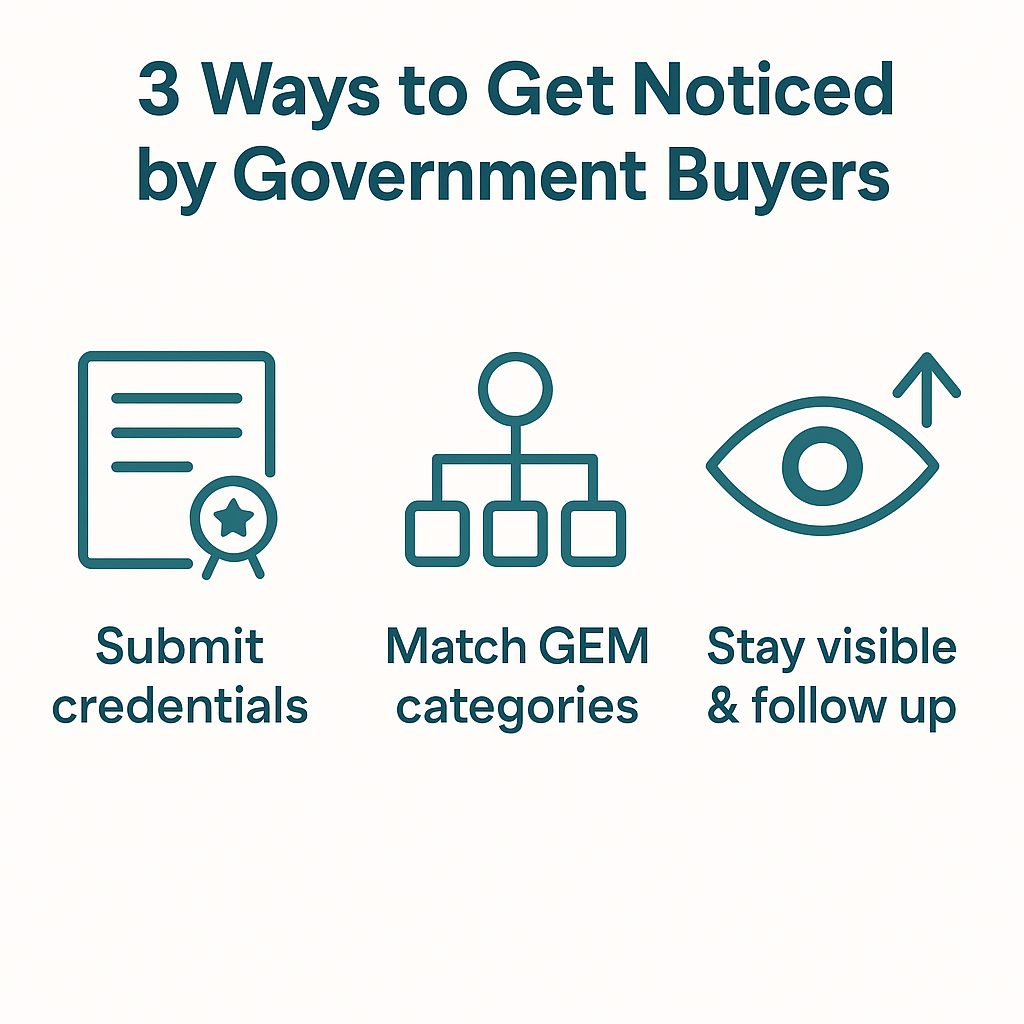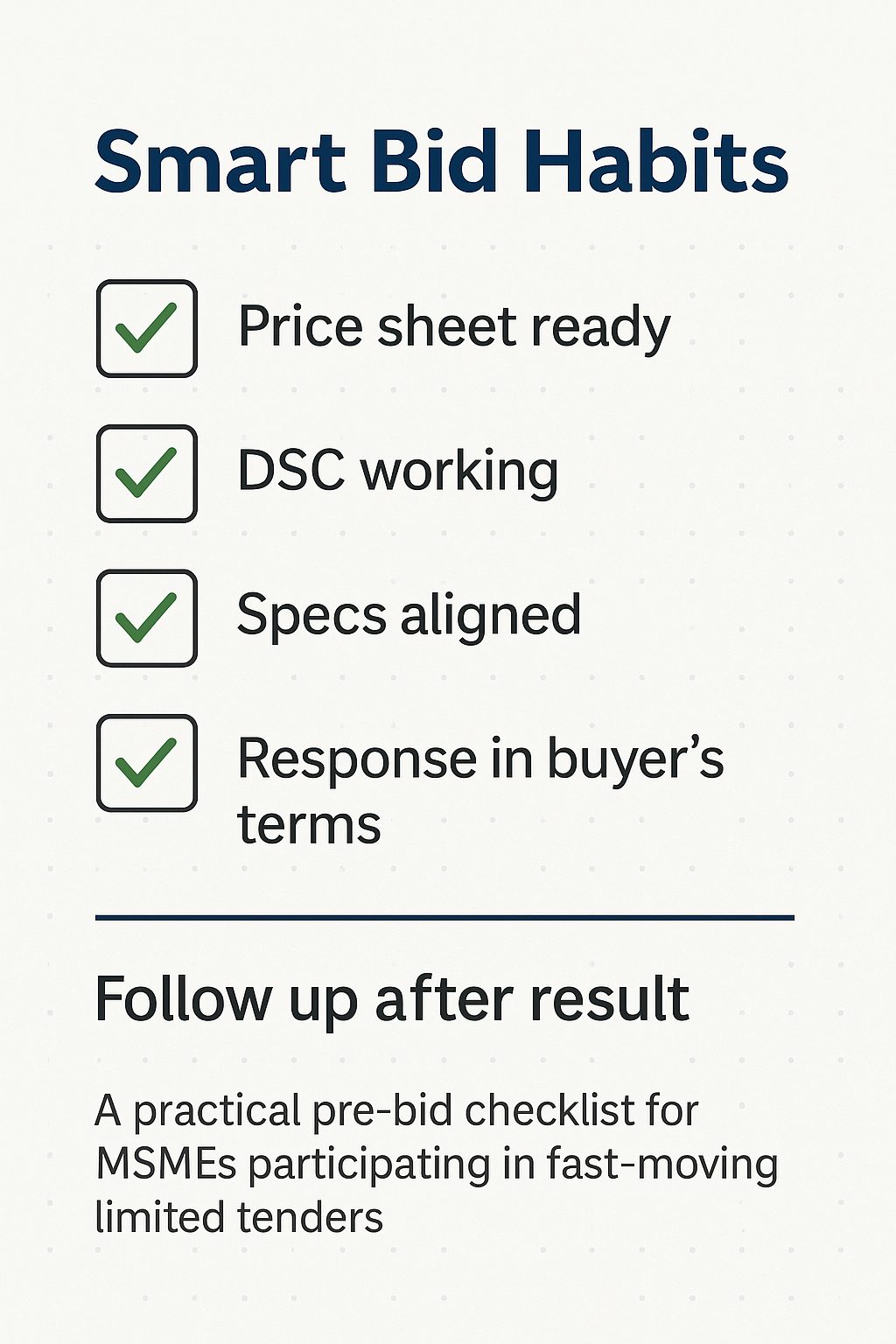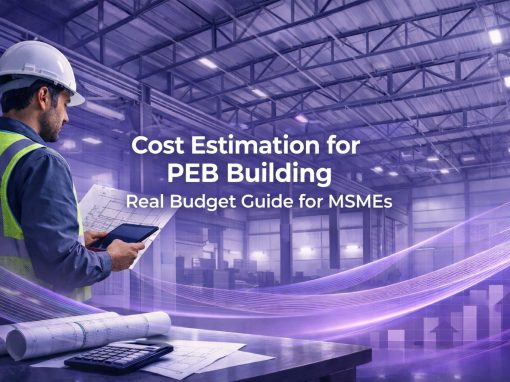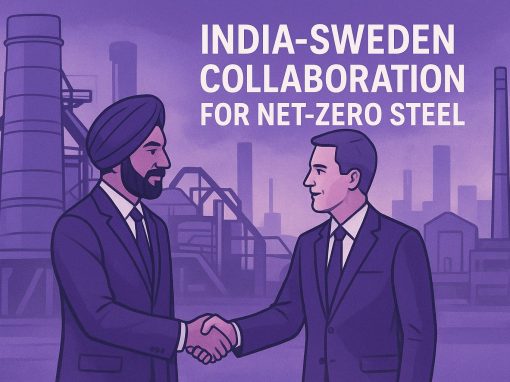Table of Contents
Here’s something many MSMEs miss at the start: not all tenders are open. In fact, some of the most actionable government opportunities never make it to public listings. They fall under what’s called limited tenders — and these operate very differently.
A limited tender is exactly what it sounds like. It’s not announced to everyone. Only a select list of vendors — usually pre-approved or empanelled — are invited to bid. These are used when the requirement is urgent, when the buyer trusts a specific set of vendors, or when the work demands specialized capability.
Now, imagine you’ve done all the basics. You’re registered on GEM. You’ve uploaded your Udyam certificate. But when the state department releases a ₹22 lakh equipment requirement as a limited tender, you don’t even hear about it. Why? Because your MSME isn’t on their invited list.
Disclaimer: This image is a representative visual created for illustrative purposes only. It does not depict an actual tender issued by any specific government department or portal.
This isn’t hypothetical. A Pune-based diagnostic tools supplier, despite having a clean GEM profile and NSIC credentials, lost out on multiple hospital orders last year. The tenders were never public. They went to an empanelled list maintained by the Directorate of Health Services. The company only found out after the contracts were awarded — too late to act.
Why are limited tenders important?
Because they’re often smaller, faster, and less competitive — exactly the kind of contracts that suit MSMEs trying to build a government track record. They’re also more common than most vendors realize, especially for recurring supply work or urgent infrastructure maintenance.
When are limited tenders used?
- For purchases below ₹25 lakh (or ₹1 crore for works)
- When departments want to avoid delays in open bidding
- When vendor capabilities are already assessed (e.g. past performance)
But here’s the key: limited tenders are not hidden — they’re selective. To be selected, your MSME needs more than just a portal registration. You need visibility with the buyer, correct registration across relevant platforms, and in many cases, prior engagement or submission of credentials directly to the department.
So before jumping into tender alerts or bidding templates, take a moment to assess where you stand. Are you visible to the departments that matter to your business? Have you ever submitted an expression of interest or reached out for empanelment?
This is where your strategy must begin — because no portal notification will help if your name’s not even in the race.
Platform-Specific Access to Limited Tenders
What most MSMEs miss is that every platform treats limited tenders differently—and that difference can cost you real business.
GeM
Let’s start with GEM, India’s flagship procurement portal. While GEM is best known for open listings and direct orders, it does allow limited bidding—but not in the way many believe. In limited tenders, buyers issue RFQs (Request for Quotations) to a filtered list of vendors based on pre-set criteria: business type, product category, verified status, and even seller rating.
Here’s where MSMEs slip. A company might upload products, set prices, and assume they’re ready to go—but unless the category mapping matches the buyer’s search filters, you’ll never receive that invite. For instance, a packaging supplier from Ahmedabad stayed invisible to buyers for months because his primary business category was incorrectly set as “retail consumables” instead of “industrial packaging.”
Central Public Procurement Portal (CPPP)
On the Central Public Procurement Portal (CPPP), limited tenders operate differently. These tenders are uploaded to the backend system but don’t appear publicly. Only vendors registered with the specific department receive email notifications. It’s subtle, but crucial. If your DSC is expired, your profile is missing documents, or your email isn’t verified—you’ll never know the tender existed.
One case stands out. A Hyderabad-based civil contractor missed out on a ₹38 lakh CPWD repair tender. Why? His DSC had expired two weeks before the invite, and he only noticed the notification buried in his spam folder days after the deadline passed.
State Portals
State portals are even more fragmented. In most cases, state departments maintain internal empanelment lists. These aren’t visible online. You have to apply directly—often via physical forms, notarized documents, and follow-ups with the department’s procurement officer.
Take Karnataka’s RDPR portal. Vendors not on the Panchayat-level panel never receive limited tender invites, even if they’re registered on the portal. In cases like these, MSMEs must go beyond digital registration—they need physical presence, calls, sometimes even hand-delivered documents.
In short? Being listed on a portal doesn’t guarantee you’ll be seen. Each platform—and each department within it—has its own rules. Learn them. Align with them. Or you’ll keep wondering why opportunities never reach you.
MSME Registration Essentials to Access Limited Tenders
Getting registered on GEM or CPPP isn’t enough if you want to receive limited tender invitations. That’s the first reality MSMEs need to accept. These tenders don’t go to everyone — they go to vendors whose paperwork, classification, and digital credentials are perfectly aligned with what departments are searching for.
Things that you need to be ready with
- A valid Udyam certificate (double-check your NIC codes — they determine your category match)
- PAN and GSTIN, tied to your business name exactly as registered
- A Class 3 Digital Signature Certificate (DSC) in the name of your authorised signatory
- A bank account proof — cancelled cheque or passbook with IFSC
- If you’re on GEM: an active catalogue with correct product/service codes
Now here’s where most registrations fall short — in the details.
A signage manufacturer in Delhi had all documents, but his Udyam certificate only mentioned “printing services.” So when the Ministry of Culture floated a limited tender for signage fabrication, he wasn’t invited. The system didn’t match him to the category. He found out too late. The certificate was never updated.
Another trap? Expired DSCs. This one’s a silent killer. You might not even realize it until a CPPP portal throws a red error when you try to decrypt a bid file. If your DSC isn’t renewed and registered correctly on the portal, even an invite won’t let you through.
And don’t forget EMD exemptions. If you’re a registered MSME, you can skip earnest money deposits — but only if your supporting documents are uploaded before the bid window opens. A Surat-based textile MSME once got disqualified just because the NSIC certificate wasn’t attached. The system assumed they didn’t qualify for the exemption.
Your takeaway? Don’t rush. Before bidding, review everything: DSC status, Udyam codes, uploaded certificates. If even one piece is off, your bid might never make it to the evaluation table.
How to Get Shortlisted for Limited Tenders
This is where most MSMEs hit a wall — they’ve registered, uploaded every document, maybe even applied for a few open tenders. But limited tenders? They never get those invites. The reason is simple: registration doesn’t equal visibility.
To receive limited tender invitations, your business needs to be on the department’s radar. That means being empanelled, referenced, or directly listed in the buyer’s approved vendor pool. And no, this isn’t always mentioned on the tender portal.
Start with departments where your offerings are most relevant. If you’re in construction, look at CPWD, MES, or state PWDs. For machinery or spares, target PSUs like BHEL or Coal India. Each department typically maintains a pre-approved vendor list. Some call it empanelment; others refer to it as registration of suppliers.
Disclaimer: This form is a recreated illustration for informational purposes only. It does not represent an actual document issued by any specific State Energy Department.
So how do you get onto these lists?
- Reach out directly to the buyer department — procurement section or stores division.
- Submit your credentials: Udyam, GST, PAN, product details, work experience, and client references.
- Follow up — in many states, the process is offline. Yes, that means phone calls or a physical visit.
On GEM, it’s slightly different. You improve your invite chances by optimizing your profile: right product categories, past order history, buyer ratings, and fulfillment timelines. The more accurate your match, the more likely you’ll land in the buyer’s limited RFQ filter.
And here’s the truth — sometimes, it takes persistence. Especially for new vendors. But one good response, even to a small limited tender, can open doors to recurring orders.
If your name’s not on the list today, make it known. Departments aren’t ignoring you — they just haven’t heard of you yet.
Bid Strategy for MSMEs in Limited Tender Scenarios
Getting invited is only half the journey. Once you’re in, your bid needs to deliver. Limited tenders move fast, competition is tighter, and buyers often expect quicker responses from vendors they already know. MSMEs need to approach this differently than an open tender.
Start with your pricing strategy
Don’t assume you have to quote the lowest number. In a limited pool — say 4 or 5 vendors — the focus often shifts from just price to fulfillment reliability. A Bhopal-based MSME supplying modular furniture once quoted 2% higher than a competitor but won the bid because they had a clean record of on-time delivery. The buyer told them directly: “We can’t afford delay. That’s why we picked you.”
Your technical bid matters more than many realise. This isn’t just about uploading spec sheets — it’s about showing the buyer that you understand what they need. Keep your responses clean, no fluff, and directly refer to the tender terms. One trick? Use the buyer’s language. If the tender says “annual maintenance support,” don’t say “after-sales assistance.” Match the words exactly.
Time management is crucial
Limited tenders often have short windows — 3 to 5 days max. That means you can’t waste time chasing missing certificates or scrambling for price approvals. Have a pre-approved price sheet ready for common products. Keep your DSC updated and accessible. If you need a team member to sign bids remotely, make sure the token travels.
Also, don’t ignore the post-bid phase. If you lose a bid, ask for debriefing — some departments won’t offer unless prompted, but many will share why you weren’t selected. These learnings are gold.
Finally, keep in mind: limited tenders reward readiness. There’s no time to fix errors mid-process. So the more you treat every bid like a live order — clear, quick, and complete — the better your chances of building long-term credibility with that buyer.
Conclusion
Most MSMEs don’t lose tenders — they simply never get invited. That’s the reality with limited procurement. It’s not about being better than everyone else. It’s about making sure the right people know you exist, and that your paperwork is in order when the opportunity comes.
If your documents are tight, your registration is mapped properly, and you’ve reached out to the right departments — you’re already ahead of most.
Buyers move quickly with vendors they trust. So keep your profile clean, follow up after missed bids, and stay ready to respond.
In this space, the first win isn’t the contract — it’s the invitation. Focus on earning that, and everything else follows.
Looking for the right government tenders for your business?
Tata nexarc helps MSMEs, manufacturers, and service providers find relevant government tenders across India. Discover tenders by location, category, or department, track deadlines, and get notified on time — with complete support to help you apply confidently.
FAQs
Can a newly registered MSME receive limited tender invitations?
Do limited tenders require a minimum turnover threshold?
How do I know which departments issue the most limited tenders for my sector?
Is there a central database listing limited tenders across platforms?
Can I challenge my exclusion from a limited tender?
What happens if I win a limited tender but fail to deliver?
Are limited tenders subject to public audit or transparency rules?
Is bidding in a limited tender easier than in an open tender?
Do GEM service providers help with limited tender access?
Can I use the same technical bid document for all limited tenders?
Ananya Mittal blends a background in data science with a passion for writing, contributing to Tata Nexarc’s efforts in creating insightful, data-informed content for MSMEs. Her work focuses on exploring sector-specific challenges and opportunities across procurement, logistics, and business strategy. She is also involved in leveraging analytics to strengthen content performance and deliver actionable insights to India's growing B2B ecosystem.
